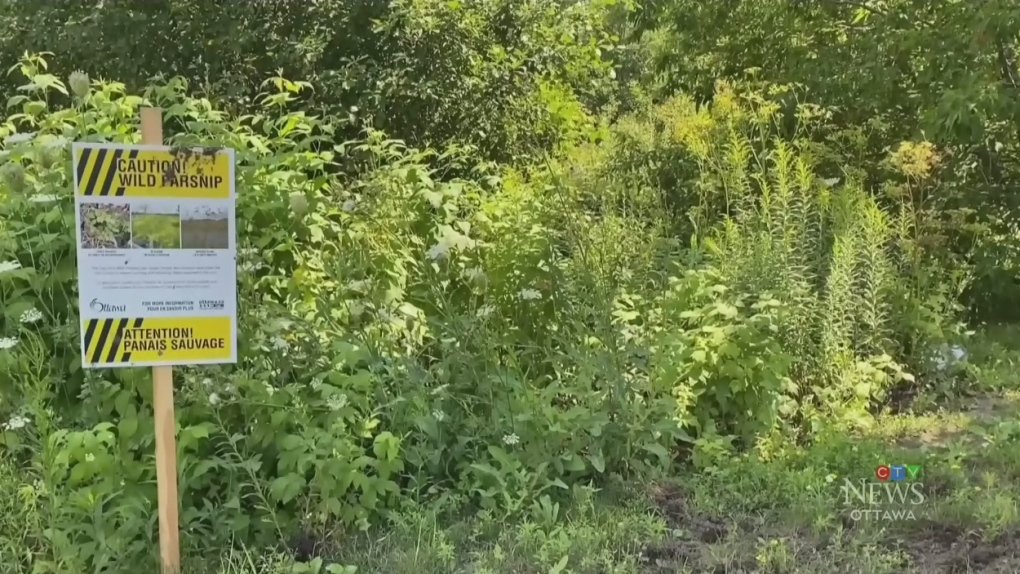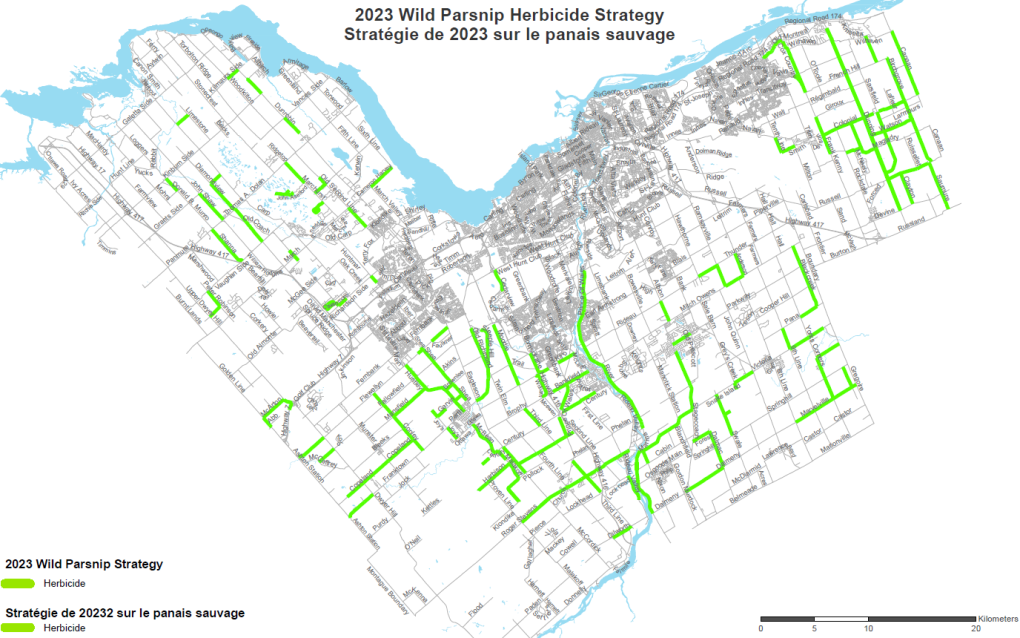Ottawa to begin spraying and mowing wild parsnip in suburban and rural areas

The city of Ottawa will begin spraying and mowing roadsides, pathways and parks this week to deal with wild parsnip, the invasive plant that can cause skin and eye irritation and make the skin prone to burning and blistering.
Approximately 650 lane kilometres of roadsides and pathways and over 200 park locations in suburban and rural areas will be treated with herbicides and mowed over the next few weeks and months.
"The goal is to reduce the growth of wild parsnip in highly infested areas while ensuring that environmentally sensitive areas and public safety are not adversely impacted," Allison Wilson, manager of technical operations with Public Works, said in a memo to Council.
In addition to the application of herbicides in highly infected areas, staff will continue, "mowing operations, adjusting frequency and timing to best coincide with herbicide applications."
Wilson says a "Notice of Herbicide Use" advertisement will appear in local newspapers one week prior to the start of spraying in public locations. Signs will also be posted every 100 metres along pathways and parks.
The Wild Parsnip Program will begin on Monday, with spraying in city parks to begin on June 6, weather permitting. Roadside grass cutting will also begin in early June.
The city will spend $298,000 to deal with wild parsnip this spring and summer.
Wild parsnip has been identified as a noxious weed in Ontario since Jan. 1, 2015.
Rural property owners can ask the city not to spray the areas adjacent to their property.
"Should a resident opt-out of the program, it will become their responsibility to manage any wild parsnip infestation adjacent to their property, as required by the Weed Control Act, 1990," Wilson says.
 The city of Ottawa released a map outlining where herbicides will be sprayed along roadsides/pathways and parkland to deal with wild parsnip. (City of Ottawa/memo)
The city of Ottawa released a map outlining where herbicides will be sprayed along roadsides/pathways and parkland to deal with wild parsnip. (City of Ottawa/memo)
Identifying wild parsnip
Wild parsnip is a highly branched plant, with hollow green stems, according to the city of Ottawa's website.
"It has two growth stages: non-flowering leafy rosettes at ground level and 0.5 to 1.5 metre-tall flowering plants."
The city outlines the stages of growth for wild parsnip on its website:
- Early growth: In the first year of growth, low-growing non-flowering rosettes of leaves form with a cluster of spindly, compound leaves that resemble celery leaves.
- In bloom: When wild parsnip is in bloom, usually in the second and third-year plants have tall, branched yellow flowering stalks that usually bloom in early June to late July.
- Mature plant: Starting in August the blooming plant will begin to turn brown and the leaves and stems will begin to dry up. This means that the toxic sap from the plant will also begin to dry up, and contact with the plant is less likely to cause a reaction.
How to avoid the plant
The city of Ottawa offers the following tips to avoid wild parsnip on pathways and in parks:
- It is recommended that the public stay on the groomed areas of parks, roadsides and pathways where there are less instances of wild parsnip.
- When working around wild parsnip or when walking through dense vegetation, wear goggles, gloves, long pants and long-sleeved shirts.
- Children should be reminded not to pick wild flowers
- If you are exposed to the plant sap, wash the contaminated area(s) thoroughly as soon as possible, and seek medical attention if skin irritation occurs
CTVNews.ca Top Stories

Grandparents killed in wrong-way crash on Hwy. 401 identified
A 60-year-old man and a 55-year-old woman killed in a wrong-way crash on Highway 401 earlier this week have been identified by the Consulate General of India in Toronto.
Police arrest 3 Indian nationals in killing of B.C. Sikh activist Hardeep Singh Nijjar
Three people have been arrested and charged in the killing of B.C. Sikh activist Hardeep Singh Nijjar – as authorities continue investigating potential connections to the Indian government.
Suter scores late goal, clinches series for Canucks
Pius Suter scored with 1:39 left and the Vancouver Canucks advanced to the second round of the NHL playoffs with a 1-0 victory over the Nashville Predators on Friday night in Game 6.
TD worst-case scenario more likely after drug money laundering allegations: analyst
TD Bank Group could be hit with more severe penalties than previously expected, says a banking analyst after a report that the investigation it faces in the U.S. is tied to laundering illicit fentanyl profits.
Quebec man who threatened Trudeau, Legault online sentenced to 20 months in jail
A Quebec man who pleaded guilty to threatening Prime Minister Justin Trudeau and Premier François Legault has been sentenced to 20 months in jail.
Human remains found in rural Sask. possibly a decade old, RCMP say
RCMP say human remains found in a rural area in central Saskatchewan may have been there for a decade or more.
Britney Spears 'home and safe' after paramedics responded to an incident at the Chateau Marmont, source tells CNN
A source close to singer Britney Spears tells CNN that the pop star is 'home and safe' after she had a 'major fight' with her boyfriend on Wednesday night at the Chateau Marmont in West Hollywood.
Canadian doctor concerned new weight-loss drug Wegovy may be used inappropriately
As Wegovy becomes available to Canadians starting Monday, a medical expert is cautioning patients wanting to use the drug to lose weight that no medication is a ''magic bullet,' and the new medication is meant particularly for people who meet certain criteria related to obesity and weight.
Drew Carey is never quitting 'The Price Is Right'
Drew Carey took over as host of 'The Price Is Right' and hopes he’s there for life. 'I'm not going anywhere,' he told 'Entertainment Tonight' of the job he took over from longtime host Bob Barker in 2007.































